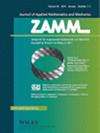Simulating body deformations with initial stresses using Hooke‐like isotropic hypoelasticity models based on corotational stress rates
IF 3.2
4区 工程技术
Q1 MATHEMATICS, APPLIED
Zamm-zeitschrift Fur Angewandte Mathematik Und Mechanik
Pub Date : 2023-10-09
DOI:10.1002/zamm.202300568
引用次数: 0
Abstract
Abstract We use isotropic hypoelastic models based on corotational stress rates to simulate deformations of elastic bodies with initial stresses. Four material models based on different corotational stress rates are used: the Zaremba–Jaumann, Green–Naghdi, logarithmic, and Hill models. The main result of the study are new objective algorithms for integrating stresses that provide sufficiently accurate values of stresses for large time steps. In addition, a new approach to symmetrizing tangent stiffness matrices that has a clear mechanical interpretation was used in computations. All four material models were implemented in a homemade FE system for nonlinear analysis of deforming bodies. The developed algorithms were verified and validated by solving both uniform deformation problems that have exact solutions and applied problem of plate bending with non‐equilibrated initial stresses. The performance of the developed software was assessed by comparing numerical solutions obtained using this software with similar solutions obtained using the commercial MSC.Marc nonlinear FE system. Comparative analysis of the obtained solutions shows that our software is comparable in performance with one of the leading commercial software packages for solving problems of isotropic hypoelasticity with initial stresses.基于旋转应力率的虎克类各向同性低弹性模型模拟具有初始应力的体变形
摘要采用基于旋转应力率的各向同性低弹性模型模拟具有初始应力的弹性体的变形。采用了基于不同旋转应力率的四种材料模型:Zaremba-Jaumann模型、Green-Naghdi模型、对数模型和Hill模型。该研究的主要成果是新的客观的应力积分算法,该算法可以在大时间步长下提供足够精确的应力值。此外,在计算中采用了一种新的方法来对称切线刚度矩阵,该方法具有明确的力学解释。在自制的变形体非线性有限元分析系统中实现了四种材料模型。通过求解具有精确解的均匀变形问题和具有非平衡初始应力的板弯曲应用问题,对所开发的算法进行了验证。通过比较使用该软件获得的数值解与使用商用MSC获得的类似解来评估开发的软件的性能。Marc非线性有限元系统。得到的解的对比分析表明,我们的软件在性能上可与解决具有初始应力的各向同性低弹性问题的领先商业软件包之一相媲美。
本文章由计算机程序翻译,如有差异,请以英文原文为准。
求助全文
约1分钟内获得全文
求助全文
来源期刊
CiteScore
3.30
自引率
8.70%
发文量
199
审稿时长
3.0 months
期刊介绍:
ZAMM is one of the oldest journals in the field of applied mathematics and mechanics and is read by scientists all over the world. The aim and scope of ZAMM is the publication of new results and review articles and information on applied mathematics (mainly numerical mathematics and various applications of analysis, in particular numerical aspects of differential and integral equations), on the entire field of theoretical and applied mechanics (solid mechanics, fluid mechanics, thermodynamics). ZAMM is also open to essential contributions on mathematics in industrial applications.

 求助内容:
求助内容: 应助结果提醒方式:
应助结果提醒方式:


